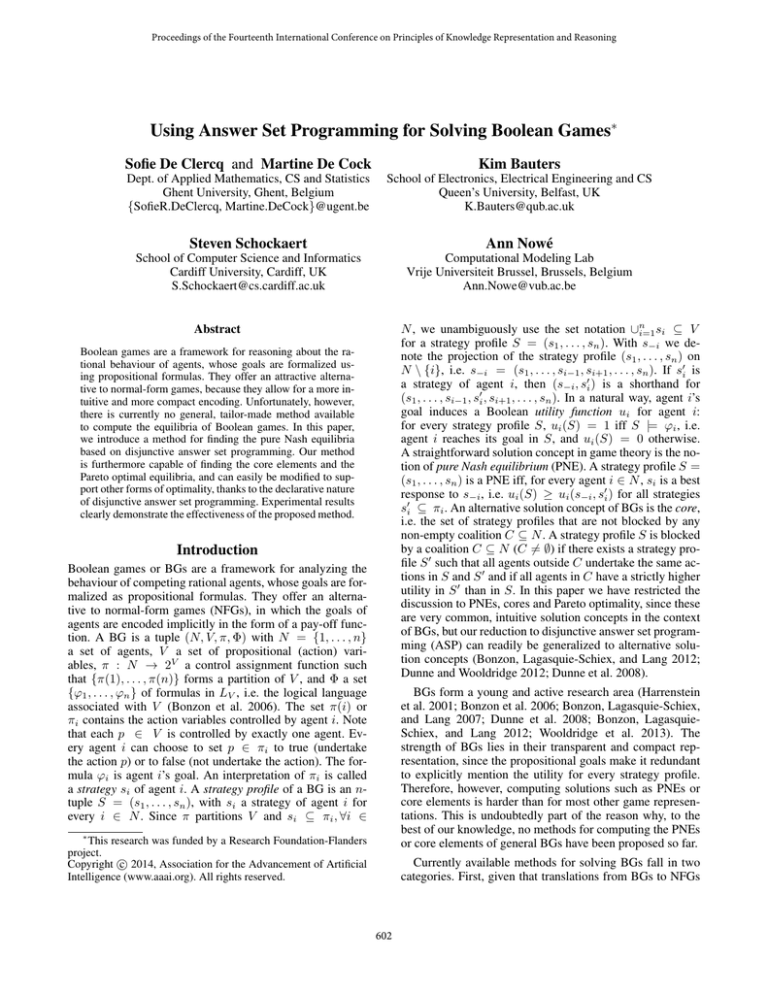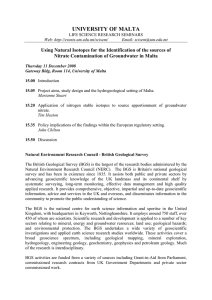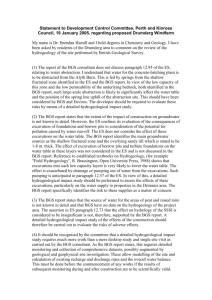
Proceedings of the Fourteenth International Conference on Principles of Knowledge Representation and Reasoning
Using Answer Set Programming for Solving Boolean Games∗
Sofie De Clercq and Martine De Cock
Kim Bauters
Dept. of Applied Mathematics, CS and Statistics
Ghent University, Ghent, Belgium
{SofieR.DeClercq, Martine.DeCock}@ugent.be
School of Electronics, Electrical Engineering and CS
Queen’s University, Belfast, UK
K.Bauters@qub.ac.uk
Steven Schockaert
Ann Nowé
School of Computer Science and Informatics
Cardiff University, Cardiff, UK
S.Schockaert@cs.cardiff.ac.uk
Computational Modeling Lab
Vrije Universiteit Brussel, Brussels, Belgium
Ann.Nowe@vub.ac.be
N , we unambiguously use the set notation ∪ni=1 si ⊆ V
for a strategy profile S = (s1 , . . . , sn ). With s−i we denote the projection of the strategy profile (s1 , . . . , sn ) on
N \ {i}, i.e. s−i = (s1 , . . . , si−1 , si+1 , . . . , sn ). If s0i is
a strategy of agent i, then (s−i , s0i ) is a shorthand for
(s1 , . . . , si−1 , s0i , si+1 , . . . , sn ). In a natural way, agent i’s
goal induces a Boolean utility function ui for agent i:
for every strategy profile S, ui (S) = 1 iff S |= ϕi , i.e.
agent i reaches its goal in S, and ui (S) = 0 otherwise.
A straightforward solution concept in game theory is the notion of pure Nash equilibrium (PNE). A strategy profile S =
(s1 , . . . , sn ) is a PNE iff, for every agent i ∈ N , si is a best
response to s−i , i.e. ui (S) ≥ ui (s−i , s0i ) for all strategies
s0i ⊆ πi . An alternative solution concept of BGs is the core,
i.e. the set of strategy profiles that are not blocked by any
non-empty coalition C ⊆ N . A strategy profile S is blocked
by a coalition C ⊆ N (C 6= ∅) if there exists a strategy profile S 0 such that all agents outside C undertake the same actions in S and S 0 and if all agents in C have a strictly higher
utility in S 0 than in S. In this paper we have restricted the
discussion to PNEs, cores and Pareto optimality, since these
are very common, intuitive solution concepts in the context
of BGs, but our reduction to disjunctive answer set programming (ASP) can readily be generalized to alternative solution concepts (Bonzon, Lagasquie-Schiex, and Lang 2012;
Dunne and Wooldridge 2012; Dunne et al. 2008).
Abstract
Boolean games are a framework for reasoning about the rational behaviour of agents, whose goals are formalized using propositional formulas. They offer an attractive alternative to normal-form games, because they allow for a more intuitive and more compact encoding. Unfortunately, however,
there is currently no general, tailor-made method available
to compute the equilibria of Boolean games. In this paper,
we introduce a method for finding the pure Nash equilibria
based on disjunctive answer set programming. Our method
is furthermore capable of finding the core elements and the
Pareto optimal equilibria, and can easily be modified to support other forms of optimality, thanks to the declarative nature
of disjunctive answer set programming. Experimental results
clearly demonstrate the effectiveness of the proposed method.
Introduction
Boolean games or BGs are a framework for analyzing the
behaviour of competing rational agents, whose goals are formalized as propositional formulas. They offer an alternative to normal-form games (NFGs), in which the goals of
agents are encoded implicitly in the form of a pay-off function. A BG is a tuple (N, V, π, Φ) with N = {1, . . . , n}
a set of agents, V a set of propositional (action) variables, π : N → 2V a control assignment function such
that {π(1), . . . , π(n)} forms a partition of V , and Φ a set
{ϕ1 , . . . , ϕn } of formulas in LV , i.e. the logical language
associated with V (Bonzon et al. 2006). The set π(i) or
πi contains the action variables controlled by agent i. Note
that each p ∈ V is controlled by exactly one agent. Every agent i can choose to set p ∈ πi to true (undertake
the action p) or to false (not undertake the action). The formula ϕi is agent i’s goal. An interpretation of πi is called
a strategy si of agent i. A strategy profile of a BG is an ntuple S = (s1 , . . . , sn ), with si a strategy of agent i for
every i ∈ N . Since π partitions V and si ⊆ πi , ∀i ∈
BGs form a young and active research area (Harrenstein
et al. 2001; Bonzon et al. 2006; Bonzon, Lagasquie-Schiex,
and Lang 2007; Dunne et al. 2008; Bonzon, LagasquieSchiex, and Lang 2012; Wooldridge et al. 2013). The
strength of BGs lies in their transparent and compact representation, since the propositional goals make it redundant
to explicitly mention the utility for every strategy profile.
Therefore, however, computing solutions such as PNEs or
core elements is harder than for most other game representations. This is undoubtedly part of the reason why, to the
best of our knowledge, no methods for computing the PNEs
or core elements of general BGs have been proposed so far.
∗
This research was funded by a Research Foundation-Flanders
project.
c 2014, Association for the Advancement of Artificial
Copyright Intelligence (www.aaai.org). All rights reserved.
Currently available methods for solving BGs fall in two
categories. First, given that translations from BGs to NFGs
602
are available, we can readily use solvers for NFGs. However, since such translations are exponential, this circuitous
method does not exploit the compactness of BGs. Moreover, its inefficiency increases rapidly with the number of
action variables per agent, as shown in the Experiments section. Second, several authors have proposed methods for
sub-classes of BGs. For instance, in (Bonzon, LagasquieSchiex, and Lang 2007), an algorithm is provided to compute PNEs, but only for BGs with an acyclic irreflexive part
of their dependency graph. In (Dunne et al. 2008), a bargaining protocol for BGs allows agents to negotiate in rounds. If
the logical operators in the goals are restricted to ∧ and ∨,
specific negotiation strategies yield a Pareto optimal strategy
profile during the first round. Otherwise, obtaining a solution
is not guaranteed. More important, none of these techniques
can compute the solutions of general BGs. In (De Clercq et
al. 2014), the stochastic Win-Stay Lose-probabilistic-Shift
algorithm (WSLpS) is used to find solutions of BGs. In
case all agents are able to reach their goal simultaneously,
WSLpS converges to a Pareto optimal PNE. In the Experiments section, we show that our disjunctive ASP technique
outperforms a generalized version of WSLpS for sufficiently
difficult problems.
In NFGs, deciding whether a PNE exists is NP-complete
when the game is represented by: (i) a set of agents, (ii) a finite set of actions per agents, (iii) a function defining for
each agent which other agents may influence their utility,
and (iv) the utility of each agent, explicitly given for all joint
strategies of the agent and the agents influencing it (Gottlob,
Greco, and Scarcello 2003). Deciding whether a BG has a
1
PNE, on the other hand, is ΣP
2 -complete , even for 2-player
zero-sum BGs (Bonzon et al. 2006). Deciding whether the
core of a BG is non-empty is also ΣP
2 -complete (Dunne et
al. 2008). In particular, the problems we tackle in this paper
are at the 2nd level of the Polynomial Hierarchy.
The aim of this paper is to introduce a solver that can compute PNEs and core elements of BGs, with the option of additionally enforcing Pareto optimality or taking into account
constraints (Bonzon, Lagasquie-Schiex, and Lang 2012) and
costs (Dunne et al. 2008). Our solver, available online2 , is
based on disjunctive ASP, a form of declarative programming (Baral 2003). In recent years, a range of ΣP
2 problems
have been identified on which ASP solvers outperform other
state-of-the-art methods (Faber, Leone, and Ricca 2005). For
our BG solver, we use the state-of-the-art ASP solver DLV
to compute answer sets.
profiles. Intuitively, the idea is to create a program with 3
parts: (i) a part describing strategy profiles and checking the
satisfaction of the agents’ goals, (ii) a part describing alternative strategies for all agents and checking the corresponding satisfaction of the agents’ goals, (iii) a part checking
whether or not the agents can improve their utility by deviating from the strategy profile in the first part and selecting
the PNEs by saturation.
Let G = (N, V, π, Φ) be a BG. We start by adding the
facts agent(i) ← for every i ∈ N and action(p) ← for every
p ∈ V to the first program part P1 . Next, we add a rule to
express that every p ∈ V is either undertaken or not:
act(P ) ∨ ¬act(P ) ← action(P )
(1)
The capital letter P is a variable, and the rule means that
if there exists a constant p such that the literal action(p) is
true, then either act(p) or ¬act(p) should be true. For every
agent i ∈ N , we add a ‘rule’ that checks whether its goal is
satisfied or not:
goal(i) ← ϕi (act(V ))
(2)
The notation ϕi (act(V )) represents the formula ϕi in which
every p ∈ V is replaced by act(p). Note that the syntax
of ASP does not allow an arbitrary formula in the body,
but we translate these ‘rules’ into valid ASP rules. First
our solver transforms the goals of the agents into negationnormal form (NNF). Then ‘rules’ of the form goal ← ϕ,
with ϕ a propositional formula in NNF, are recursively translated to ASP rules by introducing new atoms. For instance,
a ‘rule’ goal ← ((a ∧ b) ∨ ¬c) ∧ d is replaced with the set
of rules {goal ← z, d; z ← a, b; z ← ¬c}, with z a newly
introduced atom. We refer to the solver’s implementation2
for more details.
The second program part is denoted as P2 . We add the
following rules to P2 , stating that every action is either undertaken or not in the alternative strategies:
act’(P ) ∨ nact’(P ) ← action(P )
(3)
Using saturation requires simulating the strong negation ¬
with a prefix ‘n’. The intuitive idea is to make all the literals of P2 true in the third program part, therefore using
¬act’(P ) instead of nact’(P ) would lead to contradictions.
By definition, the utility of every agent who individually deviates from a PNE cannot be strictly higher than its utility
in the PNE. To know if the strategy si is a best response
to s−i for agent i, it suffices that either ui (s−i , si ) = 1 or
ui (s−i , s0i ) = 0, ∀s0i ⊆ πi . Therefore it suffices to know
whether ϕi is false for i’s alternative strategy in P2 . To this
end, we add the following ‘rules’ to P2 for every i ∈ N :
Computing PNEs and Core Elements of BGs
with Disjunctive ASP Programs
ngoal’(i) ← nϕi (act(π−i ), nact’(¬πi ), act’(πi ))
We first show how to compute PNEs of a BG by associating it with a disjunctive ASP program. To this end, we use
the saturation technique (Eiter, Gottlob, and Mannila 1997;
Baral 2003) to compare answer sets and select the desired
solutions. In our case, answer sets correspond to strategy
(4)
with nϕi the notation for a formula, equivalent to ¬ϕi , in
NNF. The notation nϕi (act(π−i ), nact’(¬πi ), act’(πi )) is
the formula nϕi in which every occurrence of p ∈ π−i is
replaced by act(p), every occurrence of ¬p with p ∈ πi is
replaced by nact’(p) and every other occurrence of p ∈ πi
is replaced by act’(p). As for (2), we translate (4) into valid
ASP rules. With X 0 we denote the set of all newly introduced atoms during the translation of (4).
1
This is also known as NPNP -complete, a complexity class at
the 2nd level of the Polynomial Hierarchy.
2
http://www.cwi.ugent.be/BooleanGamesSolver.html.
603
The third program part P3 checks whether the strategy of
agent i chosen in P1 is a better response than its alternative
strategy in P2 , given the strategies of the other agents in P1 .
If so, we derive pleased(i) with the following rules of P3 :
pleased(I) ← goal(I);
pleased(I) ← ngoal’(I)
one of 13 types, determined by three parameters: (i) personal preference: (a) join the project, (b) do not join, and
(c) no preference; (ii) positive partnership (only relevant if
level 1 is not (b)): (a) no condition, (b) only join a project
if at least one partner joins, and (c) only join a project if
all partners join; and (iii) negative partnership (only relevant if level 1 is not (b)): (a) no condition, and (b) only join
the project if no anti-partners join. For each agent, we (uniformly) choose the personal preference, and based on this
choice we (uniformly) choose among the allowed positive
and negative partnerships. The type of an agent influences
its goal. For example, agent i of type (c,b,b) has two partners j and k and one anti-partner l for a project m. Then
the sub-goal of agent i corresponding to project m becomes
m
m
m
m
(pm
i ∧ (pj ∨ pk ) ∧ ¬pl ) ∨ ¬pi . So either agent i joins the
project with j or k and without l, or agent i does not join.
The overall goal of an agent is formed as the conjunction of
the sub-goals corresponding to all the projects. All problem
instances, problem generators and solvers have been made
available at http://www.cwi.ugent.be/BooleanGamesSolver.
html. The measurements have been performed on a dual
CPU system with two 2.4GHz Intel Xeon six core E5-4610
processors and 8GB RDIMM.
Since there are currently no solvers for general BGs, there
are only few options for a baseline. We consider two baselines: an NFG solver and a heuristic approach. In this paper we use on the one hand a standard approach to compute
PNEs of NFGs in ASP (De Vos and Vermeir 1999), which
we call the NFG baseline. To use it on BGs, we need to
translate the BGs to NFGs, compute the PNEs and translate
these PNEs back to BG format. Our second baseline uses the
stochastic and iterative algorithm WSLpS on BGs as suggested in (De Clercq et al. 2014), but after each iteration, we
verify whether the obtained strategy profile is a PNE or core
element. For some classes of BGs, it can be shown that this
algorithm is guaranteed to converge to a PNE without checking the best response condition (De Clercq et al. 2014) but
in general it should be regarded as a heuristic method. Since
WSLpS is stochastic, we run this baseline 25 times per BG.
(5)
If all agents have a better response in P1 than in P2 , we derive sat using the following rule of P3 , in which the body literals are compactly denoted in a set. Moreover, we exclude
answer sets in which sat is not derived:
sat ← {pleased(i) | i ∈ N };
← not sat
(6)
As part of the saturation technique, we set the literals introduced in P2 to true if sat is derived, by adding the following
rules to P3 for every x ∈ X 0 :
act’(P ) ← sat, action(P ); ngoal’(I) ← sat, agent(I)
nact’(P ) ← sat, action(P );
x ← sat
(7)
Together with (5), (7) implies that all literals of the form
pleased will also be made true if sat is derived. The entire
program P1 ∪ P2 ∪ P3 is called the PNE-program induced
by G. Note that the ΣP
2 -complexity of deciding whether
there is a PNE in a BG matches the ΣP
2 -complexity of our
grounded disjunctive ASP programs (Baral 2003). We can
prove that this ASP encoding is correct, i.e. that there is a
one-to-one correspondence between the answer set of the
induced PNE-program and the PNEs of the BG.
Adjusting the ASP program, we obtain an analogous result for core elements. Both encodings are generalized to an
extended BG framework, allowing constraints on the possible strategies of the agents (Bonzon, Lagasquie-Schiex, and
Lang 2012) and costs, imposed on agents depending on their
chosen strategy (Dunne et al. 2008). Similarly, we have extended our encoding to additionally enforce Pareto optimality on the solutions. Due to space constraints, we refer to
the implementation of our solver for more details.
Experiments
Experimental Set-up
Results
We evaluate the performance of our ASP based method on
instances of a structured problem, which we call project
BGs. The problem consists of n persons, who can work on
several projects. Depending on the project, each person has
his preferences concerning the people he might collaborate
with — partners — and the people he does not want to collaborate with — anti-partners. Someone who is not a partner,
is a non-partner. Partnership and anti-partnership relations
are anti-reflexive, not necessarily symmetric and project dependent. The project BGs are inspired by a BG about people being invited to a party (Bonzon, Lagasquie-Schiex, and
Lang 2007; Dunne et al. 2008). We include 3 parameters
for project BGs: (i) the number of agents, (ii) the number of
projects and (iii) the probability of an agent being another
agent’s partner and the probability of a non-partner being
an anti-partner. In a project BG, every agent i controls an
action variable pm
i per project m, interpreted as joining the
project. For every project, every agent is randomly assigned
In a first experiment, we compute 1 PNE for project BGs
with a timeout of 5 minutes. The number of agents varies
from 5 to 50. For each fixed number of agents, we generate
100 BGs with 1, 2 or 3 projects and a 50% probability that an
agent is another agent’s partner and that a non-partner agent
is an anti-partner. The median computation times, within
a 95% confidence interval, are plotted in Figure 1. The results show that dASP strongly outperforms the NFG baseline. It also outperforms WSLpS if the number of agents
is sufficiently high. The higher the number of projects, the
smaller the number of agents at which dASP starts outperforming WSLpS. Note that for a wide range of parameters,
dASP still succeeds in finding a solution for all problem instances, whereas both baselines consistently time out.
Secondly, we compute core elements instead of PNEs.
Since the NFG baseline is not capable of computing core
elements, we limit the experiments to WSLpS and dASP.
For the same range of parameters as before, we compute
604
5
10
15
20 25 30 35
Number of Agents
40
45
2 Projects
5
10
4
10
3
10
2
10
1
10
0
10
50
MCT 1 PNE (ms)
MCT 1 PNE (ms)
MCT 1 PNE (ms)
1 Project
dASP
NFG
WSLpS
5
10
4
10
3
10
2
10
1
10
0
10
dASP
NFG
WSLpS
5
10
15
20 25 30 35
Number of Agents
40
45
3 Projects
5
10
4
10
3
10
2
10
1
10
0
10
dASP
NFG
WSLpS
5
50
10
15
20 25 30 35
Number of Agents
40
45
50
dASP
WSLpS
5
10
15
20 25 30 35
Number of Agents
40
45
50
2 Projects
5
104
103
102
101
100
10
dASP
WSLpS
5
10
15
20 25 30 35
Number of Agents
40
45
50
MCT 1 CORE (ms)
1 Project
5
104
103
102
101
100
10
MCT 1 CORE (ms)
MCT 1 CORE (ms)
Figure 1: Median computation time (ms) of 1 PNE in project BGs.
3 Projects
5
104
103
102
101
100
10
dASP
WSLpS
5
10
15
20 25 30 35
Number of Agents
40
45
50
Figure 2: Median computation time (ms) of 1 core element in project BGs.
Median
Computation Time
1 solution (ms)
1 core element in 100 project BGs. The results are plotted
in Figure 2. We observe that dASP consistently outperforms
WSLpS for the more difficult problems instances.
Finally we investigate the scalability of our approach on
project BGs with 2 projects, extended with costs and constraints. The constraints enforce that an agent can join at
most 1 project. For both projects, an individual cost of
0, 1 or 2 is randomly assigned to joining the project. Not
joining involves no costs. There are between 5 and 50 agents
and we consider 100 BGs for each parameter setting. With a
timeout of 10 minutes, respectively 1 PNE, 1 Pareto optimal
PNE (POPNE), 1 core element or 1 Pareto optimal core element (POCORE) is computed. Note that no comparison with
the baselines is made, since those are not equipped to deal
with costs and constraints, nor to compute Pareto optimal
solutions. The results are plotted in Figure 3. As expected,
computing a PNE takes less time than computing a core element and enforcing Pareto optimality further increases the
computation time of a PNE. For core elements, enforcing
Pareto optimality does not demand more time. Although
the computational cost is generally higher for stronger solution concepts or for BGs involving costs and constraints,
our method remains suitable for medium-sized problems.
6
10
5
10
4
10
3
10
2
10
1
10
lems, called project BGs, we showed that our disjunctive
ASP based method outperforms both a NFG based method
and a heuristic method called WSLpS on sufficiently difficult problems, although for small instances WSLpS was
faster on average. We also demonstrated the effectiveness of
our method to find solutions under the presence of costs and
constraints, and when Pareto optimality is required.
References
Baral, C. 2003. Knowledge Representation, Reasoning and Declarative Problem Solving. New York: Cambridge University Press.
Bonzon, E.; Lagasquie-Schiex, M.-C.; Lang, J.; and Zanuttini, B.
2006. Boolean games revisited. In Proc. ECAI, 265–269. ACM.
Bonzon, E.; Lagasquie-Schiex, M.-C.; and Lang, J. 2007. Dependencies between players in Boolean games. In Proc. ECSQARU,
743–754. Springer.
Bonzon, E.; Lagasquie-Schiex, M.-C.; and Lang, J. 2012. Effectivity functions and efficient coalitions in Boolean games. Synthese
187:73–103.
De Clercq, S.; Bauters, K.; Schockaert, S.; Mihaylov, M.; De Cock,
M.; and Nowé, A. 2014. Decentralized computation of Pareto optimal pure Nash equilibria of Boolean games with privacy concerns.
In Proc ICAART ’14. Forthcoming.
De Vos, M., and Vermeir, D. 1999. Choice logic programs
and Nash equilibria in strategic games. In Proc. CSL, 266–276.
Springer.
Dunne, P. E., and Wooldridge, M. 2012. Towards tractable Boolean
games. In Proc. AAMAS, 939–946. IFAAMAS.
Dunne, P.; van der Hoek, W.; Kraus, S.; and Wooldridge, M. 2008.
Cooperative Boolean games. In Proc. AAMAS, volume 2, 1015–
1022. IFAAMAS.
Eiter, T.; Gottlob, G.; and Mannila, H. 1997. Disjunctive datalog.
ACM T. Database Syst. 22(3):364–418.
Faber, W.; Leone, N.; and Ricca, F. 2005. Solving hard problems for the 2nd level of the Polynomial Hierarchy: Heuristics and
benchmarks. Intelligenza Artificiale 2(3):21–28.
Gottlob, G.; Greco, G.; and Scarcello, F. 2003. Pure Nash equilibria: hard and easy games. In Proc. TARK, 215–230. ACM.
Harrenstein, P.; van der Hoek, W.; Meyer, J.-J.; and Witteveen, C.
2001. Boolean games. In Proc. TARK, 287–298. Morgan Kaufmann Publishers Inc.
Wooldridge, M.; Endriss, U.; Kraus, S.; and Lang, J. 2013. Incentive engineering for Boolean games. Artif. Intell. 195:418–439.
2 Projects, including costs and constraints
PNE
POPNE
CORE
POCORE
5
10
15
20 25 30 35
Number of Agents
40
45
50
Figure 3: Computation of 1 solution in project BGs.
Conclusion
We proposed a method based on disjunctive ASP for finding the solutions of a BG. To the best of our knowledge,
this is the first solver which is capable of handling general
BGs (apart from methods based on an exponential translation to NFGs). Our solver can compute (Pareto optimal
or arbitrary) PNEs and core elements, even in the presence
of costs and constraints. Using a class of structured prob-
605




